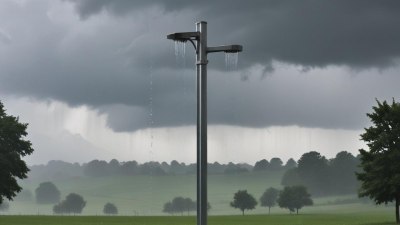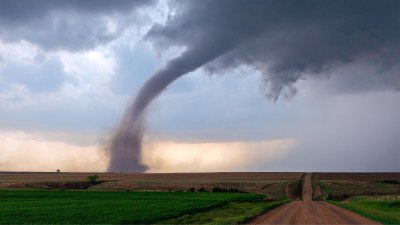She's Got Storm Cloud Eyes and a Forecast You Can't Trust
Explore the poetic symbolism and deep emotional undertones in 'She's Got Storm Cloud Eyes and a Forecast You Can't Trust,' revealing complex human moods.

In literature and poetry, the metaphor of weather is often used to articulate the intricacies of human emotion. The phrase "She's Got Storm Cloud Eyes and a Forecast You Can't Trust" serves as a vivid illustration of this tradition, merging the natural unpredictability of weather with the complexity of human feelings and relationships. This poetic expression captures not only the layered nature of emotional states but also the inherent uncertainty that accompanies interactions with individuals whose moods and intentions are unstable like a tempest on the horizon.
To unpack the rich symbolism embedded in the phrase, one must consider both components: "storm cloud eyes" and the unpredictable "forecast." Eyes are known as the windows to the soul, capable of revealing volumes of unspoken emotion through their expressions and glances. Storm clouds, by contrast, evoke a sense of impending turmoil or conflict—a looming disturbance that threatens to disrupt the calm. Together, storm cloud eyes conjure an image of deep intensity and possible menace, reflecting the inner turbulence that may reside within that person.
The "forecast you can't trust" adds an additional layer of meaning, suggesting that any expectations or predictions about this individual’s behavior are unreliable. This mirrors the nature of weather forecasting, which, despite technological advances, is never completely precise. The analogy implies that the person's moods and reactions are as changeable and unpredictable as the weather, making it difficult for others to prepare for the emotional climate they might bring.
From a psychological standpoint, the image of storm cloud eyes can represent someone who carries distress or unresolved emotions beneath their surface. It could indicate a person who is often brooding or whose expressions betray a subtle undercurrent of anxiety or sorrow. The unreliability of the forecast communicates the challenge in anticipating how these underlying feelings may manifest, whether as calm reassurance, sudden outbursts, or withdrawal. In relationships, this unpredictability can create tension and uncertainty, as others may find it hard to know how to respond or support them effectively.
In a more poetic or artistic context, the phrase also reflects the allure and danger often associated with enigmatic figures whose mystery captivates others. People are frequently drawn to those who exhibit a spirit of emotional intensity or complexity, sensing depth beyond the surface. The storm cloud eyes serve as a metaphor for that compelling mix of beauty and hazard – they might draw one in while simultaneously warning of emotional upheaval ahead.
Symbolism related to weather is pervasive in various cultural narratives. Storm clouds have historically signified change, transformation, and upheaval, but also cleansing and renewal. The image of storm clouds can denote emotional catharsis, where after a tumultuous period, growth and clarity emerge. Thus, storm cloud eyes could be emblematic of someone on the cusp of personal transformation—unsettled yet ripe for change.
The complexity of the metaphor aligns well with romantic and interpersonal dynamics. People who are described as having storm cloud eyes might be those whose passions and intentions are masked by ambiguity. Their actions and emotions might fluctuate dramatically, creating an emotional environment akin to unpredictable weather patterns. This instability can be both enticing and exhausting for those involved, making the relationship dynamic a continual process of adjustment and interpretation.
From an artistic viewpoint, this metaphor also lends itself well to visual and literary art. Imagine portraits where the eyes are painted or described as dark and heavy with clouds, casting shadows and reflections that hint at hidden depths. Such images evoke an atmospheric mood, connecting viewers viscerally to the unsettled nature of the subject. In poetry or song lyrics, this phrase condenses volumes of emotional texture into a few words, allowing audiences to project their own experiences onto the imagery and relate to the described emotional state.
Moreover, the idea that the forecast is untrustworthy hints at the notion of vulnerability in human interaction. It suggests that relying on appearances or previous patterns of behavior is futile because the subject's internal world is dynamic, shifting in ways that challenge predictability. This unpredictability can result in feelings of insecurity or doubt, making trust difficult to establish or maintain. It reflects the universal human experience of interacting with others whose moods or dispositions defy simple categorization.
The metaphor might also resonate in professional or social contexts, where individuals must navigate interpersonal relationships psychologically shrouded in uncertainty. Recognizing that someone's "storm cloud eyes" signal depths of emotion or thought that are not easily accessible requires sensitivity and emotional intelligence. The uncertainty of their "forecast" demands flexibility and patience—qualities essential in fostering effective communication and understanding.
Diving deeper, the phrase taps into the theme of emotional weather as a cycle. Just as storms eventually give way to calm skies, people too move through phases of emotional intensity and tranquility. Recognizing this cycle can be crucial for empathy and resilience. It highlights the temporary nature of difficult emotions and the potential for renewal, reminding us that beneath the storm clouds, clearer skies will emerge.
Exploring the origin of such metaphors, one finds parallels in classic literary works. Shakespeare, for example, often utilized weather imagery to depict emotional states or foreshadow events. Storms represented turmoil both external and internal, sometimes symbolizing fate or destiny. This tradition continues into modern literature, where emotional states are symbolized by natural phenomena to enrich storytelling and deepen character development.
The phrase's effectiveness lies in its concise yet evocative nature. It immediately paints an emotional landscape that is both descriptive and metaphorical, allowing readers or listeners to conjure vivid mental images. Such metaphors enhance communication by encapsulating complex feelings in accessible language, bridging abstract emotional experience with tangible sensory references.
In examining real-life applications, the metaphor may be used in various forms of dialogues and narratives to convey warning or fascination about an individual's character. It serves as a shorthand to express both admiration for the person’s intensity and caution regarding their unpredictability. This duality reflects the ambivalence often felt towards individuals who are emotionally intricate or volatile.
The interlacing of uncertainty and intensity in the phrase underlines the nature of human complexity. Very few people are entirely predictable or transparent; instead, their personalities and emotions fluctuate in response to internal and external stimuli. Acknowledging this variability is essential for authentic connection and emotional maturity. "She's Got Storm Cloud Eyes and a Forecast You Can't Trust" encapsulates this profound human truth, wrapped in poetic imagery.
From a linguistic perspective, the phrase creatively fuses imagery and idiomatic expression. "Storm cloud eyes" is a unique collocation that combines the physical eye with an abstract weather phenomenon, creating a stark and memorable metaphor. Meanwhile, "a forecast you can't trust" plays on the everyday language of weather prediction to symbolize personal unpredictability, grounding an abstract concept in familiar terms.
Furthermore, this metaphor invites contemplation about how we interpret and respond to others’ emotional cues. It draws attention to the difficulty of reading the "weather" inside a person and the potential consequences of misreading or overestimating predictability. This is especially poignant in relationships where trust and understanding are paramount. It encourages us to remain open-ended in our judgments and expect fluctuation rather than fixed states.
The phrase also resonates in the context of self-reflection. Individuals may recognize their own "storm cloud eyes," embracing the notion that they harbor intense emotions and an unpredictable nature. Accepting the internal storm as part of oneself fosters self-awareness and can lead to healthier emotional management strategies. It suggests that unpredictability is a natural facet of human experience rather than a flaw.
In creative writing or songwriting, such metaphors enrich narrative texture and emotional depth. Artists and authors strive to evoke experiential universality through metaphors that combine the known and unknown. This phrase effectively achieves that by grounding emotional complexity in the universally understood experience of weather uncertainty, facilitating empathy and connection through shared human experience.
Moreover, the metaphor bridges emotional experience with the physical environment, emphasizing how human beings often understand inner life through external phenomena. This connection is ancient and cross-cultural, reflecting humanity’s longstanding practice of interpreting nature’s moods as mirrors of our own. The storm cloud eyes symbolize a natural human condition embodied in nature's ever-changing face.
The imagery of storm clouds in eyes additionally hints at a concealed vulnerability beneath the outer intensity. Storm clouds can be ominous, but they are also carriers of rain, essential for growth and renewal. Similarly, the emotions reflected by these storm cloud eyes might include sadness, rage, or confusion, but also the potential for healing and change. This dual aspect enriches the metaphor, suggesting layers beneath surface impressions.
In social and cultural narratives, unpredictable weather has traditionally been a metaphor for fate and chance. The unreliable forecast mirrors the idea that life’s outcomes are uncertain and depend on variables beyond control. Applying this notion to human temperament resonates with the unpredictability of relationships, where despite best intentions, the future remains unwritten and subject to change.
The phrase also implies a dynamic interaction between observer and subject. Those who look into the "storm cloud eyes" must confront their own expectations and assumptions. The inability to rely on the forecast challenges the observer’s desire for certainty and control. This dynamic reflects fundamental human experiences of uncertainty and the need to navigate ambiguity in social contexts.
Expanding on the artistic potential, the metaphor invites adaptation across multiple mediums. Visual artists might explore contrast between light and dark within the eyes, contrasting the turmoil within against the exterior calm. Musicians might translate the unpredictability of the forecast into shifting rhythms or harmonies. Writers might develop characters who embody this tension, crafting narratives that explore the interplay between emotional intensity and unpredictability.
To appreciate the metaphor fully, one can also reflect on personal experiences. Many people have encountered individuals whose emotional states seem volatile or inscrutable, evoking a sense of weathering a storm. The metaphor captures not only the aesthetic but also the relational challenges of such interactions, highlighting the tension between attraction and caution.
Such imagery may inspire empathy, encouraging recognition of the complexities individuals carry. By likening emotional expression to natural phenomena, it invites compassion rather than judgment. The person with storm cloud eyes is not simply difficult but richly textured, deserving of understanding despite the challenges they present.
Exploring parallels, one might consider other metaphors in literature that combine human emotion with natural elements. For instance, "the calm before the storm" or "the eye of the hurricane" also use weather motifs to describe states of tension and release. These metaphors enrich the emotional lexicon, providing nuanced ways to articulate complex feelings.
In sum, "She's Got Storm Cloud Eyes and a Forecast You Can't Trust" is an evocative metaphor that intertwines imagery of natural phenomena with the human emotional experience. It encapsulates themes of unpredictability, intensity, vulnerability, and transformation. The phrase serves as an artistic tool, psychological insight, and cultural symbol, resonating across interpersonal, literary, and emotional dimensions.
This metaphor challenges one to embrace uncertainty and complexity in human relationships. It encourages appreciation for the multifaceted nature of feelings, reminding us that emotional landscapes are fluid and often inscrutable. By engaging with such imagery, individuals can deepen their understanding of themselves and others, fostering empathy and emotional resilience.
Ultimately, the metaphoric phrase reflects the beautiful complexity of humanity — simultaneously radiant and stormy, steady yet changeable. It offers a poetic lens through which to view the enigmatic depths present in each individual, inviting ongoing exploration and acceptance of emotional unpredictability as an inherent part of life’s experience.











